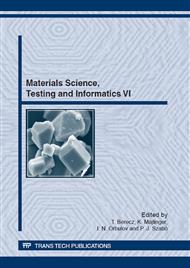p.25
p.31
p.37
p.43
p.49
p.55
p.61
p.68
p.74
Effect of Processing Conditions on Microstructure and Mechanical Behaviour of Metals Sintered from Nanopowders
Abstract:
The influence of the consolidation conditions on the microstructure and plastic behavior of ultrafine-grained Ni and Al sintered from nanopowders was studied. It was found that the smaller initial Ni powder particle size yielded a smaller grain size and a larger oxide content in the as-consolidated sample resulting in a higher strength and lower ductility. When the Ni nanopowder was in contact with air (instead of an inert atmosphere) during the short handling time before sintering, the oxide content increased without a considerable change of the grain size that also decreased the ductility. The reduced time and temperature in Spark Plasma Sintering compared to Hot Isostatic Pressing led to a smaller grain size that resulted in a higher strength of Ni. In the case of an Al nanopowder processed by Hot Isostatic Pressing at 450 °C, the consolidation was hindered by the strongly limited diffusion due to the presence of a rigid amorphous layer on the surface of particles. However, at the sintering temperature of 550 °C, the crystallization and the fragmentation of the layer occurred that yielded a better densification.
Info:
Periodical:
Pages:
49-54
Citation:
Online since:
November 2012
Authors:
Keywords:
Price:
Сopyright:
© 2013 Trans Tech Publications Ltd. All Rights Reserved
Share:
Citation:


